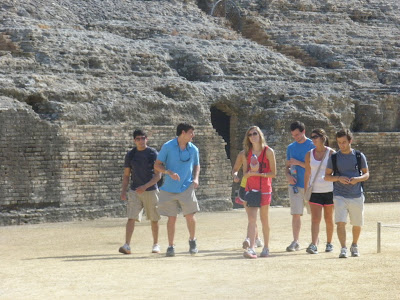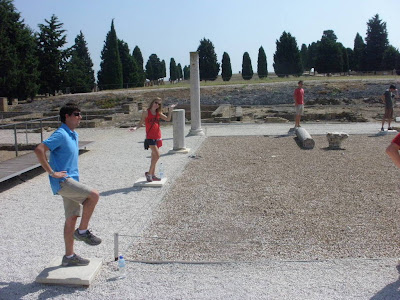At Texas Tech, all students must complete a balanced curriculum that includes study in the natural and applied sciences, social sciences, mathematics, humanities, and the visual and performing arts. Here in Sevilla, we offer fundamental engineering courses such as statics and thermodynamics and where possible, we include field trips to local sites where the students can see applications of those topics(Ybarra, Bridges, Abengoa, etc.). However, the really unique opportunities to utilize our Spanish surroundings to enhance the educational experience comes in the visual and performing arts and humanities classes. In the first summer session, we had a philosophy course taught by Dr. Anna Christina Ribeiro and music appreciation taught by Dr. Eric Fried. In the second summer session, we have theater appreciation taught by Dr. Linda Donahue and the history of Spain taught by Dr. Douglas Inglis.
Over the last 3000 years, Spain has felt the impact of virtually every great civilization and social movement, from the Phoenicians to the Romans and from Napoleon to Hitler. It is a fascinating country and our students are receiving a whirlwind tour of its history from Dr. Inglis. On Saturday morning, the Texas Tech engineering students were guided by Dr. Inglis for a tour of the ancient site of the Roman city Italica.

Italica was founded in 206 BC to settle the Roman soldiers who were part of the victory over the Carthaginians in the Battle of Llipia. The city grew in importance and was the birthplace of the Roman emperor Trajan. The capabilities of Romans as engineers was clearly evident in the carefully planned city layout with with fresh water distribution, waste removal, cobble stoned streets, elaborate homes, and public baths.



The Romans built a 25,000 seat amphitheater so that they could be entertained by their gladiators and a separate theater for dramatic productions. The students will return one evening next week for a dance performance in the theater as part of their theater appreciation class. Imagine sitting in the same seats where the Roman spectators had sat 2000 years ago for similar entertainment.


Eventually, the students started to feel a little like Roman gods themselves.



The students like to get a "Guns Up" photo at every location.

No comments:
Post a Comment